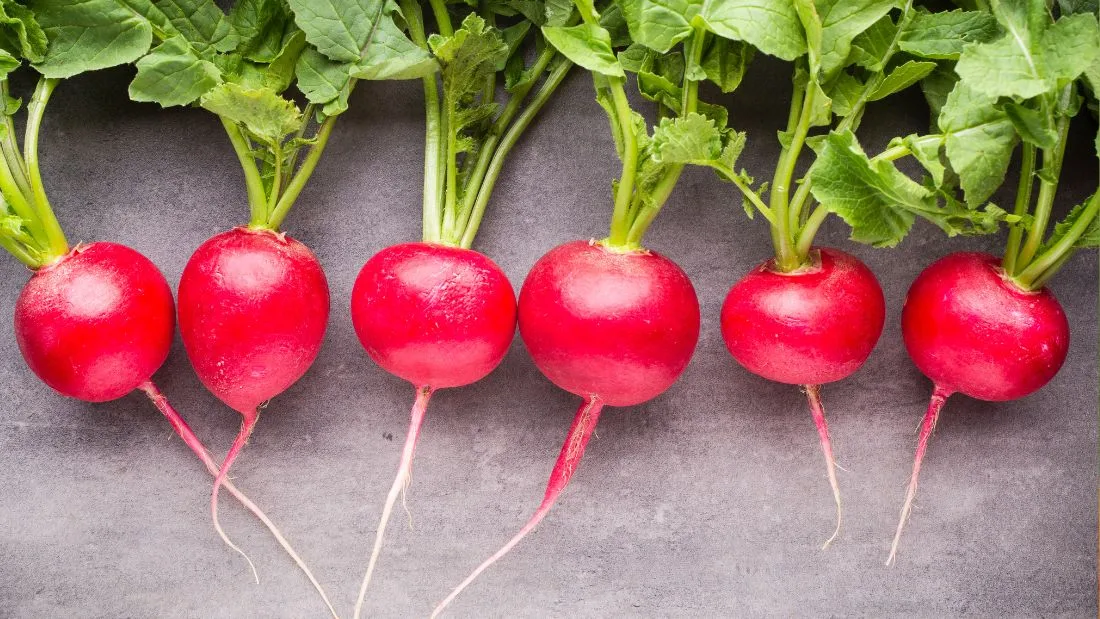Radishes

Peppery veggies with a host of health benefits
Radishes belong in the Brassica or cruciferous family and so are closely related to kale, broccoli and cabbage. We are most familiar with the round little red ones but there are many different types.
Radish nutrients
Radishes vary in colour, shape and size but are fairly similar in nutrient content. Most of their volume is, in fact, water and they are low in carbohydrates, protein and fat but they do pack a valuable bundle of vitamins and minerals.
Radishes are a good source of folate, also known as vitamin B9, needed for brain and nerve function, the production of the body’s genetic material (DNA and RNA), cell reproduction and red blood cell formation. It also plays an important role in fertility and a host of other vital functions in the human body.
Perhaps surprisingly, radishes supply decent amounts of vitamin C – just 10 radishes cover almost a fifth of your recommended daily intake. You need vitamin C for healthy skin, bones, cartilage and all other connective tissues, immune system and wound healing. It also helps you absorb iron from food, so having some radishes along with your meal boosts your iron intake.
Additionally, radishes provide a range of vital minerals but only in small amounts – calcium, magnesium, iron, potassium and zinc. Of course, the more radishes you eat, the bigger the amount of these minerals but if you only have a few with your meal, the contribution is small.
Cancer-fighting heroes
All plants in the cruciferous family contain very powerful natural compounds that have a strong anti-cancer effect – they can prevent cancer cells from multiplying and bring about their natural cell death. These compounds are called glucosinolates and their breakdown products, such as isothiocyanates, are believed to be responsible for their health benefits.
Radishes are a rich source and consuming them raw ensures the maximum effect of isothiocyanates.
What’s more, these compounds are also antioxidants and have anti-inflammatory properties which means they protect your cells and DNA from everyday damage and help to tone down inflammation in your body. And that’s not all – radishes contain a range of other antioxidants and the whole antioxidant bundle helps to lower your risk of heart disease and other chronic conditions.
The pink, purple or red hues of radishes give away the presence of a powerful antioxidant group called anthocyanins. These antioxidant pigments can support your health in a number of ways, including reducing your risk of cancer, diabetes, cognitive decline, premature skin ageing and they are antimicrobial too.
Of course, radishes are also a good source of fibre, which supports your digestive health and reduces your risk of heart disease, bowel cancer and diabetes as well.
Different types of radishes
You are probably most familiar with the little red ones, which pack the most isothiocyanates and anthocyanins but if their strong peppery taste is too much for you, daikon radish may be a safer bet. Daikon radishes are larger white roots with a milder taste and that’s why they are also great for children.
Then, there’s a huge variety of other radishes, such as white icicle radishes or watermelon radishes, but those are not widely available. As a general rule, the more colour the radish has, the more antioxidants it offers.
How to use radishes?
Some people enjoy radishes for breakfast, but despite their name, French breakfast radishes are not traditionally eaten for breakfast in France. The name is believed to originate from Victorian England, where radishes were enjoyed during breakfast or afternoon tea.
Radishes are best used raw, either sliced as a side dish or salad ingredient but you can also grate them and combine with other grated veggies and vegan mayo to make a tasty slaw. If you wish, you can cook with them too, for example slice them finely and add to stir-fries or soups, such as pho or ramen.
For radish recipe inspiration, see our Vegan Recipe Club.




